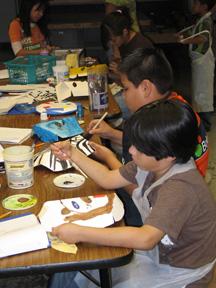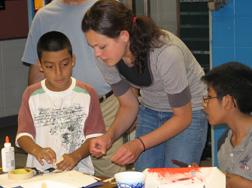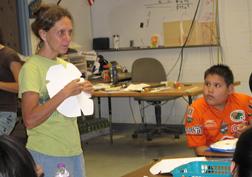Art Camp: Connecting Door County Migrant Children with Creativity
- Share
- Tweet
- Pin
- Share

The children in the Migrant Education Program work on their masks during the Hardy Gallery’s Art Camp.
It is estimated that between one and three million migrant farm workers leave their homes each year to plant, cultivate, harvest, and pack fruits, vegetables, and nuts throughout the United States. This transience is invisible to most people, but the presence of migrant farm workers in many rural communities throughout the nation is still a constant, even in the age where machines often replace human hands.
I can’t imagine that it’s easy for anyone to pick up and leave their home for a few weeks without a fair amount of effort, but for these workers, this is a very typical way of life. For the children of these migrant workers, this traveling lifestyle begins at birth, and often leads to a disruption in their educations and a disconnection from the community they inhabit for the majority of the year.
Even though many of us know about Door County’s agricultural bounty, it might surprise some readers to learn that there is still a large group of migrant workers that arrive in Door County every July to help harvest the massive cherry crop. Because many of these migrant workers have young families, the Gibraltar School District has hosted a Migrant Education Program since the 1960s, when thousands of migrant workers were needed to harvest Door County’s cherry crops by hand. Since then, cherry picking machines have replaced most of the workers – but the peninsula still sees its share of migrant workers, and Gibraltar’s program is still going strong. The program takes place over three weeks, and it ensures that migrant children benefit from the same free public education provided to other children of their age group.
The Hardy Gallery’s involvement with the Migrant Education Program dates back to the early 2000s. One of the components of the Hardy’s mission has always been to enhance the creative enrichment of local youth, and the organization saw an opportunity to collaborate with Gibraltar on a series of arts-focused activities that would blend into their existing program and allow the students to explore their personal creativity. The migrant children that are served in the program have fewer opportunities to engage in the arts than many of their peers, and the art lessons they do have (if they have any, because for many this is their first introduction to formal art classes) often lack one-on-one instruction. We developed a loose curriculum for the students and assembled several local artists and volunteers to help us execute our curriculum – and Art Camp was born!

Hardy Gallery intern Beth Servais helps one of the children secure their mask.
Planning for Art Camp (and the Gibraltar Migrant Program in general) can be challenging – the program hinges on when the cherry crop is ready to pick, and unfortunately, there’s no magic date to schedule around! To give you a bit of insight, this year’s Art Camp instructors, Door County artist Donna Brown (who has selflessly given up many a July to teach the Art Camp program) and our Hardy intern Beth Servais, solidified this year’s camp on a week’s notice upon learning that the students would be starting school on July 11 – a good two weeks ahead of schedule (last year’s program began at the very end of July)!
The 2010 Art Camp program consists of 14 children – and out of that number, six of the children are returning students. One student has been attending the camp for six years. Most of the students are from Texas, with one being from Michigan and another being from nearby Green Bay. The students range from seven to 13 years old. To that end, there are many challenges for our staff, such as finding a variety of activities that not only appeal to all ages, but also making sure not to repeat things from year’s past.
I stopped in at Art Camp in its first week, just in time for Brown and Servais to embark on their first project with the students – mask making. Brown asked the kids to think of a favorite animal as a subject for their mask, and then went around the table, asking each student what animal their mask would be. The students were shy at first, but after a few probing questions from Brown (What does your animal like to eat? Is it regular penguin or a rainbow penguin? What sounds does your animal make?), they happily began sketching, painting, and affixing feathers, antennas, and whiskers to their masks. I always marvel at how the shy and timid nature of the students seems to change in a matter of hours, which only speaks to how the arts build confidence as well as creativity.

Door County artist and instructor Donna Brown encourages the students to think of their favorite animal for a mask idea.
As I write this, Art Camp is at the beginning of its second week. In the days to come, the students will learn about positive shapes, the contrast of light and dark, and other concepts. They will create collages, mobiles, will draw as teams, experiment with sculpture, and will even learn about the performing arts. At the end of the third and final week, the Hardy will host a presentation for the students at our gallery on Ephraim’s Anderson Dock. The event is open to the entire community, and highlights the projects that the students worked on throughout the duration of Art Camp. I attended this presentation last year, and what sticks with me the most is the obvious pride these students have in their work and their involvement with the program. The group of students involved in the ending presentation is a far cry from the shy, unsure kids that gingerly sat down at the Art Camp table on that first day. I like to think that programs like Art Camp help these children hold tight to that newfound sense of creativity and excitement about the arts – an excitement that will hopefully stick with them when they travel home, and throughout the rest of their lives.
For more information about the Hardy Gallery’s Art Camp program, please visit the Hardy’s website at http://www.thehardy.org.
Peninsula Arts and Humanities Alliance, Inc., is a coalition of non-profit organizations whose purpose is to enhance, promote and advocate the arts, humanities and natural sciences in Door County.

